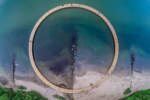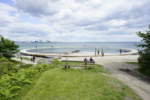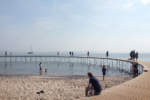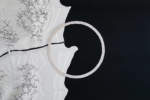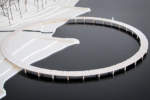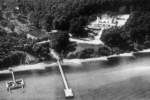architect: Gjøde & Povlsgaard Arkitekter
location: Aarhus, Denmark
year: 2015
photo by Aarhus I Billeder
“We have created a sculpture that is all about experiencing the surroundings and becoming aware of the relationship between the city and the magnificent landscape of the bay. Walking on the bridge you experience the changing landscape as an endless panoramic composition and at the same time you enter a space of social interaction with other people experiencing the same panorama,” says Johan Gjøde, partner and co-founder of Gjøde & Povlsgaard Arkitekter.
The Infinite Bridge is a sculpture by Danish architect studio Gjøde & Povlsgaard Arkitekter built and exhibited in connection with the international biennale, Sculpture by the Sea 2015. It takes place in the scenic coastal landscape surrounding the city of Aarhus.
The Infinite Bridge’s perfect circle has a diameter of 60 meters and is positioned between two dimensions: half on the beach and half in the sea. The bridge consists of 60 identical wooden elements placed on steel pillars housed about two meters into the sea floor. The deck of the bridge rises between one and two meters above the water surface depending on the tide. The curvature of the bridge follows the contours of the landscape as it sits at the mouth of a small river valley extending into the forest from the beach.In addition to unfolding the seaside panorama The Infinite Bridge establishes a connection between the present and the history of the specific site, as it reconnects the beach to a long forgotten viewpoint at sea. The architects aimed to retrace the legacy left by the original landing dock which in the past had been used by many people arriving in steamboats from the city to relax and enjoy themselves. The dock was connected with a historic, popular destination situated on the edge of the forest facing the sea: the Varna Pavilion. This building is still sitting on the hillside above the beach in the scenic landscape with its terraces, restaurant and dancehall and thanks to The Infinite Bridge, it has regained the missing interaction between the previous dock and the Pavilion. By reestablishing this historic connection, “The bridge offers a new perspective on the relationship between the city and the surrounding landscape,” says Niels Povlsgaard, partner and co-founder of Gjøde & Povlsgaard Arkitekter.
The architects are a young team whose approach is to stretch the boundaries with any project they focus on. “The philosophy behind our architect practice is to start projects on our own. Rather than waiting for a project to come about, we invent the project and get in touch with people making the decisions. In this context Sculpture by the Sea was a unique opportunity to work within the coastal protection zone of Denmark and install The Infinite Bridge in an otherwise inaccessible area,” says Johan Gjøde.
When commenting on the dividing line between art and architecture, Gjøde & Povlsgaard are very clear about their role. They are vastly experienced in designing exhibition spaces and working on projects that call for the spatial potential of a given location to be explored.
“We have worked quite a bit in the realm of art and architecture. Most of the time it is about taking a step back and allowing the art to come into its own. In these situations, you have to create a setting where people can meet and contemplate the individual art pieces in a new light. As we did with The Infinite Bridge, we have tried to create a setting where you can experience the landscape surrounding the city. Actually, it is nature, the city’s skyline, the harbor and the relationship to the water that is the true art piece,” says Johan Gjøde.


![(c) - Aarhus I Billeder [2] slideshow](https://www.area-arch.it/wp-content/uploads/sites/6/2015/07/c-Aarhus-I-Billeder-2-slideshow-1068x544.jpg)
